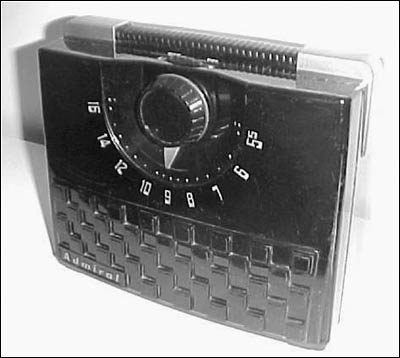Of Old Radios And Related Items--Published Monthly
Admiral 4T11 Portable Radio
By William Demetriou
Web Edition
Reading the step-by-step story of this restoration, you get the message along the way that this is a collector who really loves old radios, "even the ugly ones." We, of course, understand that sentiment and applaud his efforts to preserve radio history in any shape or form. (Editor)
It was the 1950s, and everywhere you turned manufacturers were designing portable radios by the millions. The sets were every shape, color, and size imaginable.
Although my own antique radio interests go more toward the wooden radios of the 1930s and 1940s, I still like collecting those radios of the 1950s, especially the ugly ones!
One set of the period that I have purchased is the Admiral 4T11, which looks neat and compact for a tube set. Manufactured by Admiral Corp., 3800 W. Cortland St., Chicago, Illinois, its chassis number is 4T1. The power supply is 110-120 AC-DC or 7.5 volts "A" supply and 67.5 volts "B" supply. It is an AC/DC set that operates on AC, DC, or battery.
Maybe I like it because it reminds me of a set that was on the counter in my mother's kitchen in the 1960s. I never remember my parents putting batteries in it, but I do remember my mother listening to her favorite radio station every Sunday while cooking that big Sunday dinner.

The 1951 Admiral 4T11 Portable.
The Restoration Process
This radio was not in too bad condition. It had all its knobs, and the case had no cracks or damage. I first took the set completely apart and soaked the case in a tub of soap and water while starting to work on the rest of the set. Looking at this nice compact chassis on my workbench, I decided to take the cover off the bottom of the chassis. I noticed that the line cord wires were frayed just before the plug, but the wire was still in good condition. So, I just replaced the plug with a plug of the same vintage as the radio.
Looking at the component side of the chassis, I saw three wax capacitors that were crummy, cracked, and melted. The three were as follows: a C6, a 0.25 mF bypass capacitor, a C13, a 0.047 mF, a C2, and a 100 mF rated at 150 volts. I also found an R15 surge limiter resistor (47 ohms at one watt) that looked very discolored. So, I replaced all the "iffy" components with fresh stock.
The radio has four tubes: 1R5 converter, 1U4 IF amp, 1U5 Det-AVC-AF, and 3V4 power output. I took the tubes out and tested them. All tested fine. I then did the norm and cleaned the tube sockets, cleaned the chassis, and blew out the dirt and dust between the plates of the tuning capacitor. I gave the tuning capacitor front bearings a dab of lubrication so it could turn freely with no resistance.
Everything looked okay, so I plugged it in and Wow! It played great! I could not believe how well it played. At this time, I put the chassis cover back on and polished the case that was soaking. I then reassembled the set back to factory specs. To my surprise, the radio looked and played great!
The best part of this restoration is that I did not use any test equipment, except a tube tester. I didn't have to do anything technical to get the radio to work, except to replace a few "iffy" components. I had never really worked on too many radios with this tube complement before. Digging around my shop, I came across two other portable radios with similar tube numbers. I will let you know how they turn out.
What is it about antique radio? I just love old radios. I love the way they look, I love the way they smell, and I love seeing those tubes glow.
'Til next time, I hope you find that radio you've always wanted!
Reference: Sams Photofact Folder Set #143, 1951.
(William Demetriou, 89 Hubbard Road, Bloomingburg, NY 12721. radiowilly@hvc.rr.com)
William Demetriou, N2QGX, has been interested in electronics for 30 years. He has been a radio collector for about seven years now and is a member of the Hudson Valley Antique Radio and Phono Society. Please visit their Web site at harpsny@tripod.com.
| [Free Sample] [Books, etc., For Sale] [Subscribe to A.R.C./Renew] [Classified Ads] [Auction Prices] [Event Calendar] [Links] [Home] [Issue Archives] [Book Reviews] [Subscription Information] [A.R.C. FAQ] URL = http://www.antiqueradio.com/Sep03_Demetriou_Admiral.html Copyright © 1996-2003 by John V. Terrey - For personal use only. Last revised: October 10, 2003. For Customer Assistance please contact ARC@antiqueradio.com or call (866) 371-0512 Pages designed/maintained by Wayward Fluffy Publications
Antique Radio Classified |